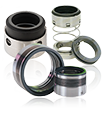Some of the industry’s toughest sealing challenges are handled with compressors. Refineries, petrochemical processing, chemical processing, food and beverage, mining, environmental and the biosciences markets can all have toxic, combustible, or caustic applications requiring the need for compressor machinery. Compressor seals in these demanding conditions must be robust and dependable, operationally safe, and cost-effective.
Common equipment styles include rotary vane, scroll, centrifugal, reciprocating, and screw compressors. Optimal seal performance rests on choosing the correct sealing system for the process application, product composition, and specific operational conditions and variables.
Wet Vs. Dry Compressor Sealing
Compressor sealing systems are either “wet” or “dry.” A wet system utilizes a thin film of oil to lubricate and act as a leak barrier. Very little gas escapes through the oil barrier; most is absorbed. This oil is degassed using methods such as heaters or flash tanks, and then recirculated back into the system.
Non-contacting, aka “dry,” compressor seals are an alternative to traditional wet (oil) seal systems. This seal system does not circulate oil; instead it may either keep seal faces separated by a film of gas (hydrodynamic) or by controlling the forces acting on the seal faces (hydrostatic.)
Seal Arrangement Options for Compressors
In addition to selecting a sealing system, there is also the choice of seal arrangements: single, tandem, or double.
Single seal arrangements are for when leakage of the product into the atmosphere is not harmful (air or nitrogen compressors) or a tandem arrangement is prohibited.
Tandem seal arrangements are used when no nitrogen is available and minimal process gas leakage to the atmosphere is acceptable. This is a preferred system when operational safety is crucial: the secondary seal is a back-up seal (normally running at a lower pressure) that can handle the full pressure in the event of a primary seal failure.
Double seal arrangements are utilized when product leakage to the atmosphere is unacceptable or for low pressure applications.
Choosing the correct sealing system for your compressor can be daunting. Flexaseal wants to make your decision process clear and provide the right product for your needs. Our Compressor Home page outlines sealing options for some of the more common compressor models. And we go one step further with a cross-reference chart providing details with model numbers, shaft sizes as well as our item numbers.
To find out more, contact one of our technical sales team by calling 1-802-878-8307 or email sales@flexaseal.com

